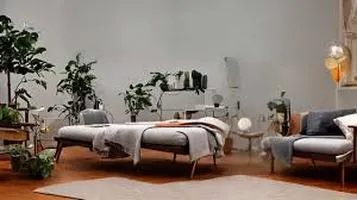Review of Multi-Functional Furniture: A Perfect Blend of Style, Utility, and Space-Saving Solutions
Multi-functional furniture is a versatile and innovative solution designed to maximize space and enhance functionality in modern living environments. Ideal for small apartments, urban living, or minimalist homes, this type of furniture integrates multiple uses into a single piece. Examples include sofa beds, extendable dining tables, storage ottomans, and modular shelving units. These pieces often feature clever design elements such as hidden compartments, foldable components, or convertible structures, allowing users to easily switch between different functions as needed. Multi-functional furniture not only optimizes space but also adds aesthetic value and flexibility to interiors, catering to the dynamic lifestyles of contemporary homeowners. Its adaptability makes it a practical choice for those seeking to balance style, comfort, and utility in their living spaces.

In recent years, multi-functional furniture has seen a surge in popularity, and for good reason. As urban living spaces become increasingly compact and the need for efficient, versatile solutions grows, multi-functional furniture offers an innovative way to maximize utility without sacrificing aesthetics. Having incorporated several pieces into my home, I am thoroughly impressed by the ingenuity, practicality, and elegance that these pieces bring to modern living.
Design and Aesthetics
Multi-functional furniture is often synonymous with contemporary design. These pieces are crafted to blend seamlessly into a variety of décor styles, from minimalist to rustic, ensuring that functionality does not come at the expense of style. My modular sofa, for instance, is a stunning centerpiece with clean lines and a neutral color palette that complements my living room. It easily converts into a guest bed, providing an extra sleeping area without the need for a bulky pull-out couch or blow-up mattress.
Additionally, the craftsmanship of multi-functional furniture is often superb. Manufacturers understand that these pieces are a significant investment, and therefore, prioritize durability and high-quality materials. My extendable dining table, which doubles as a workspace, is made from solid wood with a beautiful finish. Its sturdy construction reassures me that it will withstand the test of time and frequent use.
Space-Saving Solutions
One of the most compelling reasons to invest in multi-functional furniture is the efficient use of space. Living in a small apartment, I constantly seek ways to declutter and optimize my environment. Multi-functional furniture has been a game-changer. My lift-top coffee table, which conceals ample storage space within, is a prime example. It serves as a table, storage unit, and even a desk when I work from home. This versatility is invaluable in a compact living area.
Similarly, my wall-mounted, foldable desk has transformed how I utilize space in my bedroom. When not in use, it folds neatly against the wall, freeing up floor space. However, when needed, it provides a spacious, sturdy surface for writing or using my laptop. This kind of innovative design is perfect for small homes or studio apartments where every square inch counts.
Functionality and Versatility
Beyond saving space, multi-functional furniture offers incredible versatility. These pieces are designed with the modern lifestyle in mind, catering to the need for adaptability. Take my storage ottoman, for example. It acts as extra seating, a footrest, and provides hidden storage for blankets and pillows. It’s a simple yet effective solution for maintaining a tidy and comfortable living room.
Another favorite is my Murphy bed, which folds into the wall to reveal a bookshelf and desk. This piece is particularly advantageous in my guest room, allowing the space to function as an office most of the time, yet quickly convert into a comfortable bedroom when guests stay over. The ease of transformation and multifunctionality of such furniture make it a worthwhile investment.
Cost-Effectiveness
While multi-functional furniture can be more expensive upfront compared to traditional pieces, the long-term cost-effectiveness is evident. Investing in one piece of furniture that serves multiple purposes eliminates the need to purchase several separate items. This not only saves money but also reduces the hassle of coordinating different pieces in a cohesive design.
Moreover, the durability of multi-functional furniture means that these pieces often have a longer lifespan, reducing the frequency of replacements. In the long run, the initial higher cost is offset by the savings in both money and space.
Sustainability
Another advantage of multi-functional furniture is its contribution to sustainability. By investing in fewer, multi-use pieces, consumers can reduce their overall consumption and waste. Many manufacturers of multi-functional furniture also prioritize eco-friendly materials and practices, further enhancing their appeal to environmentally conscious consumers.
Conclusion
Multi-functional furniture is an exemplary solution for modern living. It combines style, utility, and space-saving features in a way that traditional furniture often cannot. The versatility and adaptability of these pieces cater to the dynamic needs of contemporary lifestyles, making them a prudent choice for anyone looking to maximize their living space efficiently.
From my modular sofa to the foldable desk, each piece of multi-functional furniture in my home has proven to be a valuable addition. They not only enhance the aesthetic appeal of my living space but also provide practical solutions that make everyday life more convenient. As urban living spaces continue to shrink and the demand for functional, stylish furniture grows, multi-functional pieces are likely to become a staple in many households. For anyone looking to optimize their home environment, investing in multi-functional furniture is a decision you won’t regret.






